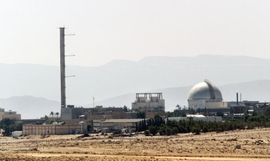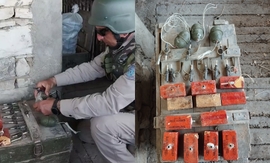The Azerbaijan National Agency for Mine Action (ANAMA) has conducted operative and urgent bomb disposal operations in the regions shelled by Armenia's forces.
Specialists of ANAMA have found 374 submunitions in ten districts and cities located far from the battlefield. The explosives were neutralized at the agency's central disposal area, according to a statement published on October 12.
“During the search operations, one 240-mm missile (M24F), one 100-mm artillery shell (OF-32), one 9M528 missile control unit, 24 remnants of exploded shells were found," read the statement.
The 9M528 is a high-explosive fragmentation missile with a 243-kilogram warhead. The rocket can annihilate targets within a 25-90 kilometer range. It is one of the main components of the Russia-made RSZO 9K58 "Smerch" multiple rocket launcher.
The renewed clashes between the Armenian and Azerbaijani forces broke out on September 27 with Armenia's troops shelling heavily the military and civilian positions of Azerbaijan. The attack prompted immediate counter-attack measures by the Azerbaijani army. Intensive deployment of military materiel on the frontline by both sides has further escalated the hostilities.
Although Azerbaijani authorities did not reveal a number for military casualties, they have confirmed 42 deaths among the civilian population with the clashes now in its third week. Armenia's shelling the densely populated residential areas in multiple zones, including major cities of Azerbaijan have also wounded 206 civilians to date.
A midnight missile fire on the country's second-largest city of Ganja on October 11 destroyed completely two residential buildings to kill 10 and wound 34 civilians. Azerbaijani authorities stated that Armenia's forces launched Elbrus tactical ballistic missile on the city. R-17 Elbrus, designated as SS-1C Scud-B by NATO, is a Russia-made short-range ballistic rocket with a range of up to 300 kilometers. It is able to carry 985 kilograms of conventional and 5-80 kilotons of nuclear warheads.
Armenia's forces launched the same missile on the strategic Mingachevir city of Azerbaijan on the same day. The air defense units of Azerbaijan have intercepted the rocket before it reached the target - the largest power station of Azerbaijan. Earlier, a missile fired from RSZO 9K58 "Smerch fall in the vicinity of the station without exploding.
ANAMA reported that from September 27-October 12, specialists of the agency have found 88 unexploded munitions, 863 9M5252 submunitions, 1,180 patrons of various caliber, 6 radio direction-finding devices, 2 unmanned aerial vehicles, 2 missile micro schemes, and 178 pieces of exploded ordnances.
Tensions between Armenia and Azerbaijan have not been easing down since the late 1980s and early 1990s. Anti-Azerbaijan sentiments in Armenia started growing in the late 1980s due to Armenia's illegal claims for the Nagorno-Karabakh region of Azerbaijan. Armenia launched a military campaign against Azerbaijan with the aim of occupying the Nagorno-Karabakh region in 1991, shortly after the dissolution of the Soviet Union, of which both Armenia and Azerbaijan were part.
The full-scale war lasted until a ceasefire in 1994. The results of the hostilities were the occupation of 20 percent of Azerbaijan's internationally recognized territory, including the Nagorno-Karabakh region and seven surrounding districts, as well as the killing of 30,000 ethnic Azerbaijanis and displacement of one million.
Although the United Nations Security Council adopted four resolutions demanding the immediate withdrawal of the occupying forces from Azerbaijani lands and the return of internally displaced Azerbaijanis to their ancestral lands, Armenia has failed to comply with all four legally binding documents.







 The Mine Action Agency of Azerbaijan (ANAMA) reported on Thursday the discovery of a significant amount of explosives in the Khojavand district of ...
The Mine Action Agency of Azerbaijan (ANAMA) reported on Thursday the discovery of a significant amount of explosives in the Khojavand district of ...
 Iran’s Foreign Minister, Hossein Amir-Abdollahian, has labeled a foiled Israeli drone attack in certain parts of the country as a "failure" for Isr...
Iran’s Foreign Minister, Hossein Amir-Abdollahian, has labeled a foiled Israeli drone attack in certain parts of the country as a "failure" for Isr...
 Iran has refuted reports of alleged damage to Shimon Peres Negev Nuclear Research Centre located southeast of Dimona, Israel, during the recent air...
Iran has refuted reports of alleged damage to Shimon Peres Negev Nuclear Research Centre located southeast of Dimona, Israel, during the recent air...



